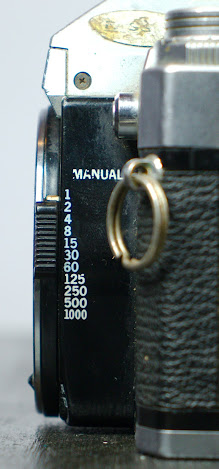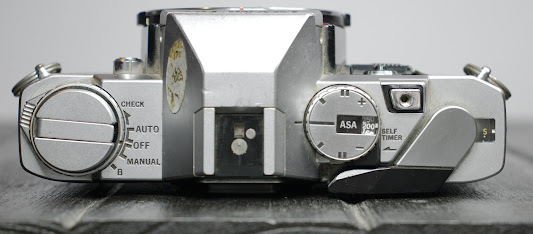Going from digital to good old film. In this post I will be talking about the Olympus OM30 film camera, a nifty piece of technology that was the “first foray into autofocus for the OM system, although strictly speaking the OM-30 is not part of the OM system, this only includes single digit models.” (Filmphotography.eu 2024)
The
importance of old film cameras is similar to the importance of camcorders
stated in the Philips VKR6847 Explorer Camcorder post and the Panasonic/National
NV-M5 Camcorder post. In both documentation of human history, but also a way to
capture that “unmistakable quality to them that digital cameras just can’t
replicate.” (Mayhigh Films 2023)
In
this post I won’t go into a deep philosophical discussion about the importance
of film cameras, instead I will direct you to my Philips VKR6847 Explorer
Camcorder post and the Panasonic/National NV-M5 Camcorder post, as well as my
last post (Nikon Coolpix S01 compact digital camera), on the significance of
these vintage pieces of film and photography technology. But I will just say
what I mentioned in my Nikon Coolpix S01 compact digital camera post and my Panasonic/National
NV-M5 Camcorder post, that if you want that old film look that film cameras
gave pictures, then it is better to use the technology from those days, instead
of using filters in the editing phase.
After
all, “film cameras have an unmistakable quality to them that digital cameras
just can’t replicate…” (Mayhigh Films 2023), but it is important to remember
that just like modern cameras, “Choosing the right film camera can be a tough
decision, but there are a few things you can keep in mind to help you choose
the best one for you. First, think about what type of photography you want to
do with your camera.” (Mayhigh Films 2023)
Now, for the Olympus OM30 camera. First a look at the company’s history. The Olympus company started in 1919 as Takachiho Seisakusho and was founded by Takeshi Yamashita and started manufacturing microscopes. Yamashita wanted to create unique microscopes and by 1920 released the Asahi.

Asahi Microscope. Image Source: https://static3.olympus-lifescience.com/data/Image/museum/micro/images/1920_01/img_01.jpg?rev=5DF8
Then
“Three decades later, Olympus successfully developed the world's first
gastrocamera for practical use. The spirit of creation that infused the company
at its founding has been passed on through the years, from the release of the
company's first product to its breakthroughs in Opto-Digital Technology today.”
(Olympus 2024)
By
1936, Olympus released their first camera, the Semi-Olympus, which “shot
6×4.5cm negatives on 120 film, a format that has faced a lot of neglect
throughout photographic history but actually enjoyed a lot of popularity in
Japan during the decades surrounding World War Two.” (Jacoby 2024)
.jpeg) |
| Semi-Olympus Camera. Image Source: https://www.olympus-global.com/technology/museum/camera/products/images/semi-oll.jpg |
This
camera was branded Olympus, which actually went back to the 1920s, when the
microscopes where branded as Olympus products (Jacoby 2024). The name comes
from Mt. Olympus, which was similar to Japan’s Mt. Takachiho, in that it was
believed that the main gods and goddesses where believed to live on these
mountains and that the Olympus trademark is “also imbued with the aspiration of
Olympus to illuminate the world with its optical devices, just like
Takamagahara brought light to the world” (Olympus 2024).
After
the Semi-Olympus, came the Six camera (1940) and the Olympus company hit, the
Olympus 35, which took the 35mm film in 1948 and by 1952 sealed Olympus’ fate
as one of the top camera companies when the 35mm film became the standard
(Jacoby 2024).
The Olympus
company went through many name changes. First founded as Takachiho Seisakusho
in 1919. Then by 1942 Takachiho Optical Co., Ltd., due to optical instruments
being the company’s foundation. After the end of the war changed their name to Olympus
Optical Co., Ltd. in 1949 to help increase company image. Then finally “in
2003, the company made a fresh start as Olympus Corporation, to show its
willingness to establish a dynamic corporate brand by unifying the corporate
name and the well-known brand.” (Olympus 2024)
This camera is part of the OM system camera series that has a long history going back to 1972 with the OM1. If you are interested in learning about it please read the article The Olympus OM System by 678 Vintage Cameras (2017) here:
https://www.678vintagecameras.ca/blog/the-olympus-om-system
Now time to look at the object of this post, the Olympus OM30. The OM30 was released between 1983 and 1987 and was also known as the OM-F camera in North America (Filmphotography.eu 2024). This particular model was most likely produced somewhere in 1983/84 because this camera was serviced only once in 1986 and according to Lomography (2024): “It’s important to remember that even though film cameras are often built like tanks, many of them have been around for decades so it would be better to have them serviced every two or so years to keep them in good condition.”
More
about the camera. It is an SLR motor camera, meaning it needs a power source to
work and the Olympus OM30 uses 5 LR44 batteries that go in a compartment
located next to the lens.
The camera comes with the standard Olympus OM-System Zuiko Auto-S 50mm lens with an f/stop of 1:1.8. It has an aperture ring on the front to allow as much or as little amount of light to enter the sensor. This is only done when the camera is set on auto, as the setting of the aperture on the lens will automatically set the shutter speed.
Set
to manual the user must use the ring on the camera body behind the lens (the
Manual Shutter Speed Dial), which sets the shutter speed manually. The slower
the shutter, the more exposure there will be and the faster the shutter speed
the less exposure there will be.
In the middle of the lens is the focus ring, that moves forward and backwards and looks like it is zooming in and out, but this ring only to fix the focus because the lens is a prime lens 50mm lens.
On
the top of the camera, there are five modes. Check is used to test battery
life, B is set for photographs that are taken with very long exposure times and
OFF switches it well… off, Shocking!
Then
there is AUTO, which as mentioned sets the shutter speed automatically
depending on the aperture setting from the lens and it is also helps with auto
focus. But this only works if the user has a “special stand alone autofocus
35-70mm/F4 zoom lens that was introduced simultaneously. This lens, shown in
the picture below, can turn any OM body into an semi-autofocus camera, with
autofocusing triggered with a button on the lens. In combination with the OM-30
however, this lens can also be triggered by the shutter release button, and in
combination with a Winder or Motor Drive and the M.In-Focus Trigger
Cord motorized single autofocus or continuous autofocus is possible.”
(ESIF.world)
.png) |
| Autofocus 35-70mm/F4 zoom lens. Image Source: page 77 of user manual |
 |
| M.In-Focus Trigger Cord. Image Source: https://i.ebayimg.com/images/g/hdoAAOSwZGRgEt6B/s-l1600.jpg |
On
top of the ring used to switch between these five modes, is the rewind knob.
This is used (with the turning the rewind release lever in the front) to wind
the film back into its capsule, similar to the Sounex YN-9000 Re-usable Camera (see
post for more information) and just like the YN-9000, to open the film
compartment, the user pulls the rewind knob up.
Next
to the mode switch is the hot shoe plate, for an external flash. Then next to
that is the ISO (ASA) setting. It is set by lifting up the Exposure
Compensation dial and turning it to the desired ISO or ISO indicated on the
film. The Exposure Compensation dial is also its own thing. It is to help with
under/over exposed photos. Moving it to the + side helps with over exposure and
– helps with under exposure (according to Elgar 2021).
In
the corner of the Exposure Compensation dial is the self-timer, that is set to
12 sec. Above that is the shutter release, which has a screw thread for the
in-focus trigger cord as well as a gas remote shutter release cable. Then there
is the Film Advance Lever, which helps move the film to the next frame when one
is used and next to that is the Exposure Counter, that tells the user on what
number frame they are on and goes up to 36 and starts with S and E at the end.
On
the front of the camera is the lens, Manual Shutter Speed Dial, the rewind
release lever and battery compartment.
But
there is also the In-Focus Trigger Cord Socket, that powers the M.In-Focus
Trigger Cord.
At
the bottom of the lens and in the corner is the F/stop knob. It switches
between F2 and F4. The user switches it depending on the lens.
.png) |
| F/stop setting guide. Image Source: Page 35 user manual. |
Underneath...
...is the Sound Switch, to put the camera on silent and also save battery power.
Above that is the Motor Guide Pinhole and next to that is the Motor Coupling Socket, then on the other side is the Motor Coupling Terminal, where the Motor Drive (a “more efficient shooting, particularly in sports and wildlife photography, and the desires of amateur and novice photographers for easier to use cameras both drove the development of automatic film transport…” Wikipedia) connects and gets power.
In the middle is the Tripod Socket.
To
know more please check out the manual here:
https://esif.world-traveller.org/om-sif/bodygroup/manuals/om30.pdf
This camera is a SLR or Single-lens reflex camera. A SLR is a “type of camera has a moveable mirror behind the lens which reflects an image through a five-sided prism (pentaprism) or pair of mirrors, onto a glass screen (the viewfinder). This means the photographer sees exactly the same image that will be exposed on the recording medium (film or digital CCD). When you press the shutter button, the main mirror is flipped out of the way so the light passes straight through to the recording medium as pictured below. As you do this, you notice the image briefly disappear from the viewfinder. There is also the familiar sound of the "camera click" as the whole mechanism works.” (Media Collage)
.png) |
| SLR camera diagram. Image Source: https://www.mediacollege.com/photography/camera/slr/images/slr-diagram-01a.gif |
The
light (made out of photons) react with the camera film in a process known as photochemistry
(Woodworth 2024). For more information on this process please check out my Kodak
200 Color Plus Film post.
This
was a fun one and more importantly short. Thank you for making it to the end
and as always, I hope you enjoyed this as much as I did researching it.
If you want to help this site out, please consider joining my Patreon: patreon.com/OnlineCurator
Please see the Please help this site post on this blog, for more information.
List
of sources:
Elgar, P. 2021. REVIEW:
Olympus OM30 Film Camera. https://www.youtube.com/watch?v=TvP-Nz7DImw
ESIF.world. OM-30
(US: OM-F). https://esif.world-traveller.org/om-sif/bodygroup/om30.htm#:~:text=It%20is%20not%20a%20true,lens%20that%20was%20introduced%20simultaneously.
Filmphotography.eu.
2024. Olympus OM-30. https://filmphotography.eu/en/olympus-om-30/#:~:text=It%20was%20built%20by%20Olympus,only%20includes%20single%20digit%20models.
Jacoby, J. 2024. A
Brief History of Olympus, From the Six to OM Digital. https://petapixel.com/history-of-olympus-om-system/
Lomography. 2024. Do
I need to get my film camera serviced regularly? https://www.lomography.com/school/do-i-need-to-get-my-film-camera-serviced-regularly-fa-51eo4nlq#:~:text=It's%20important%20to%20remember%20that,keep%20them%20in%20good%20condition.
Mayhigh Films. 2023. What
makes one film camera better than another? https://medium.com/@mayhighfilmsindia/what-makes-one-film-camera-better-than-another-73c75c172de5#:~:text=The%20benefits%20of%20using%20a%20film%20camera&text=They%20are%20generally%20less%20expensive,longer%20lifespan%20than%20digital%20cameras.
Media Collage. SLR
cameras. https://www.mediacollege.com/photography/camera/slr/
Olympus. 2024. Founding
of Olympus. https://www.olympus-global.com/company/milestones/founding.html?page=company#:~:text=Olympus%20was%20named%20after%20this,the%20predecessor%20of%20Olympus%20Corporation.
Wikipedia. Motor
drive (photography). https://en.wikipedia.org/wiki/Motor_drive_(photography)





















.png)




No comments:
Post a Comment